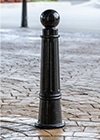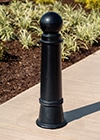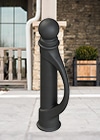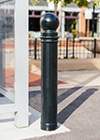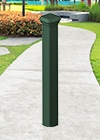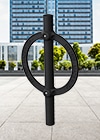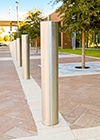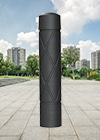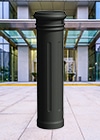From the middle of the 20th century onward, new development in American cities and towns emphasized ease of use for drivers.
It came at the cost of increased suburban sprawl and a web of arterial roads with high speed limits and a frightening lack of consideration for anyone on foot or riding a bike.
Sadly, In 2021, drivers struck and killed an estimated 7,485 pedestrians, marking the most deaths in a single year in four decades.
If you’re wondering why we’re talking about this, or what this has to do with bollards, keep reading.

Righting past wrongs in the built environment
Communities are slowly undoing the damage, realizing that their citizens thrive when everyone can safely access rights of way instead of just those who drive. Indeed, according to the U.S. Department of Transportation’s 2017 Safety for All Users Report, demand among citizens for more integrated road networks that support single-occupant driving, public transit, biking and walking all at once is on the rise.
“One of the issues when you have a one-way street with three lanes is the middle lane becomes a racetrack and drivers have little regard for pedestrians trying to cross the street. It was a bit of a game of Frogger.”
Deacon Aspinwall – City of Alamosa, Colorado
Lane reductions (also called road dieting) show much promise. These projects typically entail restriping roadways to remove at least one lane of vehicle traffic in each direction, ceding dedicated space to people on foot or riding bicycles.
But restriping is not always enough. While America has very strict traffic rules — and, for the most part, American drivers follow them religiously — actual physical barriers sometimes are needed.
As you’ll see in the brief case study below, bollards can play an essential complementary role to any effort to bring traffic speeds down and reduce the likelihood of collisions.
In Alamosa, bollards rewrite the rules of the road
The town of nearly 10,000 people is located in southern Colorado’s San Luis Valley beside the Rio Grande and surrounded by fertile farmland.
But the community felt that things were changing, especially in its historic downtown.
“Hard data from our marketing district showed visibility and economic indicators were going up, according to credit card tracking and where the origin ZIP code is on those credit cards. Our community is on the cusp of a lot of dramatic growth that our area has not seen, but other areas of the Mountain West have,” said Deacon Aspinwall, a planning and development specialist in the community, whose role it is to oversee the implementation of Alamosa’s long-range community plans.
For the community to make the most of the opportunities heading its way, it needed to reconsider the role its built environment played in the lives of those who lived, worked and played in Alamosa.
“I watched this big flatbed, overloaded with wood, stop for a pedestrian. That was very rewarding to watch. Before, nobody would stop.”
Deacon Aspinwall – City of Alamosa, Colorado
Main Street carries two U.S. Highways through the town. In 2006, the state department of transportation accommodated increased traffic volumes through Alamosa’s downtown the same way countless other communities across America have done: Main Street became a one-way thoroughfare carrying traffic westward. A block south, 6th Street carries it eastward. Vehicles travelled swiftly through the corridor.
It worked for heavy vehicle traffic, but not for anyone else who wanted to travel downtown to eat or shop on foot. It wasn’t safe.
“One of the issues when you have a one-way street with three lanes is the middle lane becomes a racetrack and drivers have little regard for pedestrians trying to cross the street,” Deacon said. “Even if you post the speed limit as 25 miles per hour, people will drive as fast as they feel they’re able to. When you have a big, wide racetrack, you’re going to drive pretty fast. It was a bit of a game of Frogger.”
Through a community-led process in 2019, a consensus was developed to envision what a vibrant downtown would look like. Thus spawned Alamosa’s Downtown Plan, and a lane reduction plan took shape: Main Street’s three lanes would become two. Some roadside parking would remain, but it would occupy what had been one of the traffic lanes. The stretches of road once reserved for parking would be repurposed for walkers and bicyclists. In addition, sidewalks would be widened.
With a vision in hand, Deacon’s role was to find a way to make that vision a reality. This is always the hard part, and it’s especially hard when a project has both functional and aesthetic requirements: The solution in Alamosa had to work, and it had to look great.

A mixture of fixtures were specified. For most of the length of the project, concrete curbing would be added to separate driving lanes from the walking and biking lane. And along the length of the curbing, stylish wooden bollards would be installed.
The curbing and wooden bollards together were meant to introduce what Deacon called “visual friction” in the environment.
“If there’s lots of things that you’re seeing out of your periphery as you drive, you’re going to drive slower,” he said.
Capping off the project were 50 decorative safety bollards from BollardsUSA. These were stationed at key intersections to provide more visual friction for drivers while creating a permeable barrier through which pedestrians or bike riders could travel.
BollardsUSA made bollard specification easy
One unique requirement for the Alamosa project was to guarantee that city service vehicles had access to the pedestrian lane if needed.
“We wanted a way to get equipment and materials into that activated space,” Deacon said.
BollardsUSA offers the ideal solution: Removable bollards featuring our patented Twist & Lock design.
“This is super helpful,” Deacon said. “We are able to remove the bollards when we need access, and then close the space off again when we’re done.”
Removable bollard installation requirements are more intensive than for permanent fixtures, but Deacon found that that was a cinch, too.
“Everything that we did had to meet state standards, which are rigorous to say the least. But BollardsUSA had the engineering specs for the mounts already done,” Deacon said. “We included those specs with our submittal package we sent off to the state for approval.”
On projects like these, civil engineers must stamp their approval on designs before the state gives its blessing. Deacon said the documentation BollardsUSA provided was so thorough, their engineer essentially “copy and pasted” them into submitted design documents.
Fast forward to the end of the project: With roadblocks removed and construction crews removing equipment and traffic cones, Deacon stood on a downtown street corner to see what would happen. Within five minutes of the road re-opening, he almost couldn’t believe what he saw.
“It was about 5:30 p.m., so kind of rush-hour type traffic. I watched this big flatbed, overloaded with wood, stop for a pedestrian. I was like, ‘Oh, man.’ That was very rewarding to watch. Before, nobody would stop.”
Alamosa slimmed down, and now they’re primed for growth
Often, city leaders use traffic volume studies as a yardstick to measure economic prospects. If you want growth, you want more traffic, not less. Right?
If there is any resistance to the concept of lane reduction and road dieting, go to Alamosa.
They re-thought what it meant to be strong and vibrant. Like any community, they sought growth. But it was a certain kind of growth — growth that welcomed everyone in town.
All it took was a good plan, the right fixtures and a committed champion. And the rewards they reap today because of it cannot be measured in how many cars pass per hour. Looking for guidance on specifying the right decorative or protective bollards for your next streetscape project? Read this in-depth guide.

